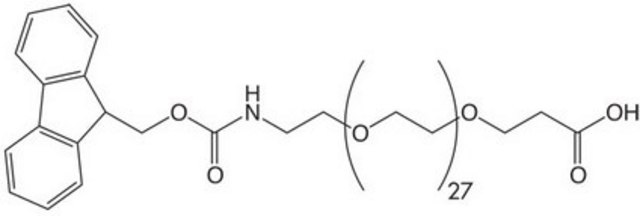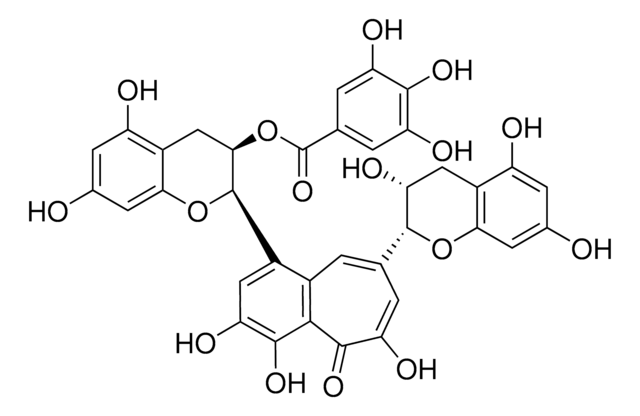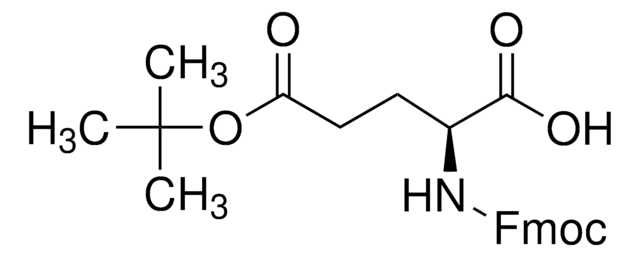推荐产品
方案
>95% (HPLC)
表单
solid or viscous liquid
反应适用性
reaction type: Pegylations
聚合物结构设计
shape: linear
functionality: heterobifunctional
运输
ambient
储存温度
−20°C
SMILES字符串
N(CCOCCOCCOCCOCCOCCOCCOCCOCCC(=O)O)C(=O)OCC1c2c(cccc2)c3c1cccc3
InChI key
VYXGUCLTEWCVRY-UHFFFAOYSA-N
特点和优势
Fmoc-N-amido-dPEG8-acid is a monodisperse PEG product that is useful for peptide synthesis. The 28-atom dPEG spacer allows the introduction of a medium-length, hydrophilic spacer onto either end of a peptide chain or between two peptide chains. The flexible dPEG spacer conjugates to peptides using conventional peptide synthesis chemistry. Peptide PEGylation imparts water solubility to hydrophobic peptide chains. Also, PEGylated peptides have expanded hydrodynamic volumes, which can reduce or eliminate renal clearance, and are protected from proteolysis. The combination of decreased renal clearance and protection from proteolysis contributes to longer in vivo circulation times for PEGylated (as compared to non-PEGylated) peptides. Additionally, PEGylation diminishes a peptide′s antigenicity. This product is part of the Fmoc-N-amido-dPEGn-acid (n=2, 3, 4, 5, 6, 8, 12, 24, 36) product series.
法律信息
Products Protected under U.S. Patent #s 7,888,536 & 8,637,711 and European Patent #s 1,594,440 & 2,750,681
dPEG is a registered trademark of Quanta BioDesign
储存分类代码
11 - Combustible Solids
WGK
WGK 3
闪点(°F)
Not applicable
闪点(°C)
Not applicable
法规信息
新产品
Guangchang Zhou et al.
Molecular bioSystems, 8(9), 2395-2404 (2012-07-10)
Robust methods for highly parallel, quantitative analysis of cellular protein tyrosine kinase activities may provide tools critically needed to decipher oncogenic signaling, discover new targeted drugs, diagnose cancer and monitor patients. Here, we describe proof-of-principle for a novel protein kinase
Ignacio Melgar-Asensio et al.
Investigative ophthalmology & visual science, 59(10), 4071-4081 (2018-08-12)
Drug delivery by intravitreal injection remains problematic, small agents and macromolecules both clearing rapidly. Typical carriers use microparticles (>2 μm), with size-related liabilities, to slow diffusion. We recently described cationic nanoparticles (NP) where conjugated Arg peptides prolonged residence in rat
Jared F Stefanick et al.
ACS nano, 7(9), 8115-8127 (2013-09-06)
Ligand-targeted nanoparticles are emerging drug delivery vehicles for cancer therapy. Here, we demonstrate that the cellular uptake of peptide-targeted liposomes and micelles can be significantly enhanced by increasing the hydrophilicity of the targeting peptide sequence while simultaneously optimizing the EG
Ian W Hamley
Biomacromolecules, 15(5), 1543-1559 (2014-04-12)
The remarkable diversity of the self-assembly behavior of PEG-peptides is reviewed, including self-assemblies formed by PEG-peptides with β-sheet and α-helical (coiled-coil) peptide sequences. The modes of self-assembly in solution and in the solid state are discussed. Additionally, applications in bionanotechnology
我们的科学家团队拥有各种研究领域经验,包括生命科学、材料科学、化学合成、色谱、分析及许多其他领域.
联系技术服务部门








